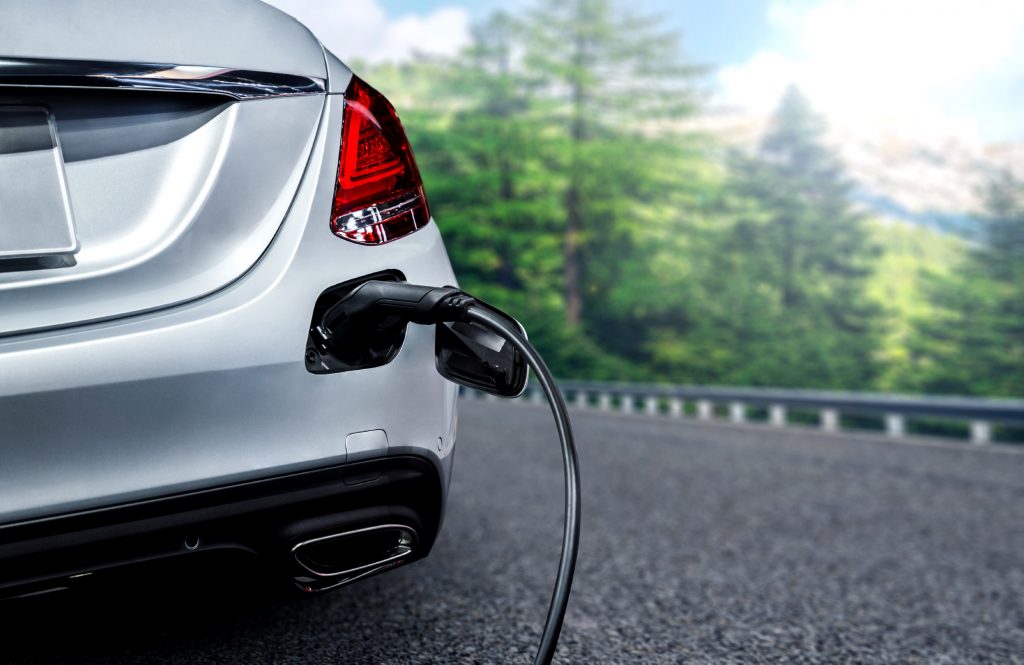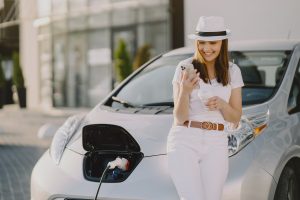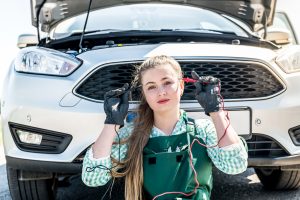
Road Trip with an Electric Car – 6 tips to follow before heading on a journey
Table of Contents
Do the principles of economic driving apply to the use of an electric car? Absolutely, yes. It’s especially noticeable, when you’re going on a trip with an electric car. What’s more, most of these principles are the same for both electric and internal combustion engine cars. Most people have a pretty good understanding of these principles, although they are not always willing to apply them. So what can you do to make your electric car go further and cheaper?
Planning a trip with an electric car
First rule – smooth driving
A smooth ride is the basic principle that allows this regardless of the type of drive. The purpose of the drive is always to provide the energy to start, give the vehicle the planned speed and maintain it. Any acceleration that does not serve these three basic purposes is a waste of energy. Therefore, within reason and for your own safety and the safety of other road users, you should avoid unnecessary acceleration. By the way, what’s the rush when you’re heading on your vacation making a nice trip with an electric car?
However, in the case of electric cars, braking allows us to recover energy and increase driving time, especially in the urban cycle. Each electric car has a recuperation system, that is recovering a lot (even up to over 80%) of energy generated during braking, when the engine works as a generator charging the batteries. In case of combustion engines this energy is converted into heat and actually means irretrievable loss. So recuperation allows to significantly increase the driving time on a single charge, especially when driving on busy city streets. Low speeds and frequent, not abrupt braking, allows to recover quite a large amount of energy.
Second principle – adapting speed to real needs
The energy of the car engine is used while driving for 2 basic purposes: overcoming rolling resistance (the force of friction of the tires against the ground) and overcoming air resistance. Beyond a certain limit (the range is large, as it depends on many factors) of roughly 40 km/hr, the resistances are roughly similar, but the form of their increase with speed, definitely not. Rolling resistance increases linearly with speed, aerodynamic resistance with its square. That is, an increase in speed from 40 to 80 km/h means +/- twice the rolling resistance and four times the air resistance. From 40 to 160 km/h it is 4 and 16 times respectively. You can’t go too slow on the highway, but going fast is a killer for the driving economy.
When it comes to air resistance, electrics have it a little better, because an internal combustion car requires air access to the engine compartment, and this necessarily increases resistance. But it’s not just design that matters here. What can you do to reduce drag? Take a look at rule five.
The biggest problem when planning a road trip with an electric car? The vast majority of drivers respond to such a question immediately – the range. There is still a myth that an electric car is not able to drive any longer distance, and the range miles disappear much faster than we actually drive. It’s a myth. You don’t have to plan every ride carefully, because new electric cars can be driven for a week without plugging them in.
Examples? Popular brands are introducing their e-cars on the market. This is important, because electric cars are finally becoming reasonably priced. Typical urban proposals have a range of 250-300 km. Electric SUVs offer much more – depending on the car version the range is even 500 km. Studies show that the average European driver does not drive more than 30-50 km per day. Many, if they drive only on the route home-work-home, close to a dozen kilometers.
Modern electric cars do not have the slightest problem with driving on expressways. They efficiently accelerate to such speeds, while driving they are well soundproofed and stable, and the range on the road no longer decreases at an alarming rate. Even the base versions will allow for a really long trip (about 350 km), not to mention the top ones, where we have WLTP and 500 km. But the fact is that on the expressway and highway the range is lower than in the city. For a simple reason. We drive all the time at a constant speed. In city traffic, when we often brake and reduce speed, the electric car constantly recharges the batteries, using the so-called recuperation. On the road it can not do this. So it may happen that during a long trip with an electric car we will have to pull over for a recharge.
Third rule – planning stops
No matter whether you drive a classic car or an electric car, you always have to plan stops. First of all, for safety reasons. A moment of rest, tea, a short walk and stretching your legs is essential. Especially when you are driving with your family and do not want to endanger our loved ones. Therefore, it is worth combining such a break with a quick recharge of the car. Some of them need only 40 minutes to charge from 0 to 80 percent.

And how to find such a fast charger? There are of course special applications for smartphones. However, manufacturers of electric cars also upload a special version of navigation with marked chargers. When you enter the route Warszawa-Gdańsk into the system, the navigation system itself will show you where you can charge your car. With one click we can add the station as an intermediate destination.
Fourth rule – minimize additional power consumption
Everything that runs in a car consumes energy, which in the case of an electric is also used to power the vehicle. So whether you use air conditioning, heat your car heavily, or use everything you can (radio, high-powered speakers, window heater, wipers, washer, etc.). This can significantly reduce the range, as the analysis of the power consumption structure warns. According to a simple calculation, an electric car’s range of, say, an average of about 250 kilometers at an outside temperature of 30 degrees with air conditioning lowering it inside by ten degrees can reduce the range by 22% to 195 kilometers. We’re not urging anyone to drive in the strenuous heat of summer or in a frighteningly cold car in winter or to bend safety rules by not using wipers, blinkers or lights. However, lowering the heating temperature by a few degrees or forgoing air conditioning is a small sacrifice that can translate significantly into the range covered on a single charge.
Additionally, electric cars are often equipped to heat only the driver’s seat. This saves energy in the winter without heating the entire cabin interior. It is worth to pay attention whether our desired model has it.
Fifth rule – anticipatory driving
Don’t just watch the road ahead, but also look further ahead. Especially in the city, where the speed changes very often, it is worth deciding a few seconds earlier on braking or accelerating (traffic lights at intersections, pedestrian crossings, dense traffic of other vehicles, narrowing of the road, traffic jams, etc.). As we mentioned earlier, recuperation with calm, anticipatory city driving gives surprisingly good results when it comes to energy recovery.
In principle, an electric car drives very similarly to an internal combustion engine, but the dashboard features some previously unknown gauges and the cockpit has buttons that may not be present in a petrol engine. It will be easier for drivers familiar with automatic transmission to find their way around. Although there is no gearbox at all in an electric car (except for specific designs), the driving experience is almost identical. After taking a seat behind the wheel, all you have to do is press the Start button (in some cars, we turn the classic key). After checking the systems, the car will report (green light) readiness to drive. All you have to do is to select the D range (using the button or lever) and… that’s it. Press the gas and drive enjoying all advantages of a trip with an electric car.
Depending on the class and version, you will find virtually the same driving assistance systems in “electric” cars: distance control in traffic jams, cruise control, systems monitoring blind spots in mirrors or driver fatigue.
Sixth rule – perform routine car maintenance
There are also questions about the maintenance of electric cars. From the driver’s point of view, the requirements are smaller than in the case of a combustion car. Besides checking the state and inflation of tires, the driver must have “ears open” for any rattles coming from the chassis – the chassis system is practically no different from the classic cars, so it may have the same problems. Under the hood, service is limited to refilling the windshield washer fluid and checking the coolant level.
It is also worth paying attention to the 12V battery. You will ask: why it in the car? The answer is simple – with such voltage works most of the devices in the cabin (from lights to central locking). What is more, a car with a discharged battery will not start at all! But this is not a problem, because you can “borrow” electricity. It will be even easier, because you do not need to turn the engine, but only to “wake up” the electronics. In the same way, an electric car can become a “donor” of electricity, but – despite the huge battery under the floor – its possibilities are limited, because the 12V battery does not have a large starting current.

If we talk about changing pads, any mechanic should be able to handle it. In turn, the high-voltage installation can be “approached” only by a person with qualifications. Inspections should not be expensive, because there is not much to do.
Where is electromobility best developed?
After looking at best practices for electric cars, it’s worth addressing their popularity. A good example would be Europe, where electromobility is most likely to grow, although many reports point to China as the best developed market for electric cars.
Read more: Usage of electric cars – what drives the EV adoption?
Hybrids accounted for 18.4 percent of total EU passenger car sales in the first quarter of 2021, nearly doubling their market share in a year, according to the latest ACEA data. All-electric cars, meanwhile, account for 5.7 percent of all new cars and plug-in hybrids for 8.2 percent of EU registrations.
And while gasoline and diesel still account for 65.4 percent of the EU car market, their sales are declining. Between January and March 2021, interest in diesels fell 20.1 percent year-on-year to 593,000 559 cars sold across the European Union. Petrol cars also continued their downward trend, with sales down 16.9 percent from 1.3 million units sold in Q1 2020 to 1.1 million units this year.
When analyzing the ACEA data, one important issue should be noted. It is about differences in the development of electromobility in particular countries. There is a report that Germany tops the electromobility ranking in Europe, with 64 thousand 809 passenger electric cars registered in Q1 of this year. Second place, with a result half as high, goes to Great Britain – 31 thousand 779, and third place goes to France with 30 thousand 491 registrations.
If the non-EU UK is removed from the podium, Italy comes in third with 13,000 266 registrations. “Further down the list the differences literally turn into a chasm. In countries such as Spain (3,449 registrations), Portugal (1,579 registrations) or even Austria (6,622 registrations) the figures are much smaller”. – we read. The sad conclusion, however, is that in almost half of the EU countries the number of registrations did not exceed one thousand units in Q1 2021.
Related stories:
Usage of electric cars – what drives the EV adoption?
Polish automotive legend in new robes. This is the electric Fiat 126 Vision
Benefits and challenges of having autonomous cars on our roads